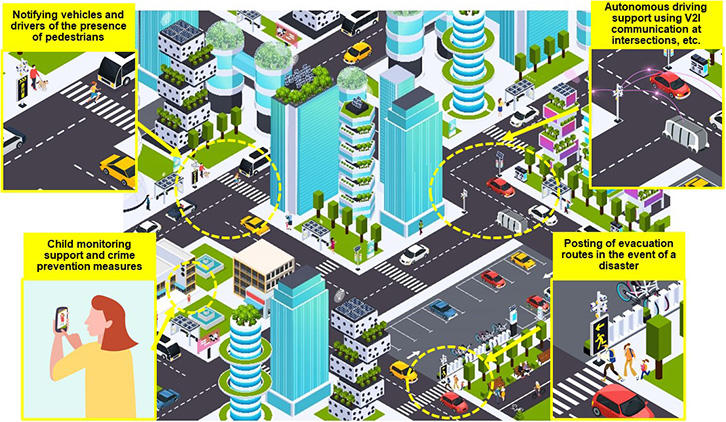Toyota Tsusho Corporation (hereinafter: Toyota Tsusho), Panasonic System Networks R&D Lab. Co., Ltd. (hereinafter: PSNRD), Kyocera Corporation (hereinafter: Kyocera), and Nippon Signal Co., Ltd. (hereinafter: Nippon Signal) announced the establishment of the "Smart Mobility Infrastructure Technology Research Partnership" (hereinafter: SMICIP) on November 30 to address the challenges in the transportation society. SMICIP will promote research and development of "Smart Mobility Infrastructure," a system that notifies vehicles, bicycles, and pedestrians of danger information detected by V2X*1 radio equipment such as ITS Connect*2 installed in vehicles and infrastructure facilities. Through research and development for infrastructure coordination support for autonomous driving and collection and utilization of traffic flow data, we aim to realize a safe, secure, and comfortable transportation society for all people.
*1 V2X, which stands for "Vehicle to X," is a technology that enables communication and cooperation between vehicles and various things. By equipping a car with various devices and parts and having it constantly connected to a computer network, the convenience of driving improves. V2X mainly has connection destinations such as "Vehicle-to-Vehicle," "Vehicle-to-Infrastructure", "Vehicle-to-Pedestrian," and "Vehicle-to-Bicycle."
*2 A driving support system that utilizes Vehicle-to-Infrastructure (V2I) and Vehicle-to-Vehicle (V2V) using the ITS dedicated frequency (760MHz).
1. Background of Establishment
By promoting research and development utilizing the technologies and knowledge of the four companies, SMICIP will contribute to the early realization of a safe, secure, and comfortable transportation society free from accidents and traffic congestion. New transportation infrastructure technologies are expected to be developed based on the following social backgrounds.
⑴ Although the number of traffic fatalities and injuries has been decreasing year by year in recent years due to technological improvements in advanced driver assistance systems (ADAS) installed in vehicles, there is a strong need to develop technologies that link pedestrians, vehicles, and roads with sensors and radio equipment, etc., to achieve zero traffic fatalities and injuries.
⑵ It has become increasingly difficult to realize autonomous driving only with on-board sensors on ordinary roads where vehicles, bicycles, and pedestrians are mixed. In such road environments, technical support from the transportation infrastructure side is needed.
⑶ The collection and utilization of data on traffic information is an essential element in the development of infrastructure for regional living areas, the re-design of public transportation, the maximum utilization of regional transportation resources, the construction of sustainable logistics systems, and the development of technology to enable the collection of such data is desired.
2. SMICIP Research Details
(1) Research on roadside infrastructure technology to support the reduction of traffic accidents.
This project aims to establish the infrastructure coordination and support technologies necessary for zero traffic fatalities and injuries. Specifically, in cooperation with relevant ministries, agencies, and various private organizations, we will establish effective accident reduction methods using smart mobility infrastructure, define the functions and quality of infrastructure that meet these requirements, and study the feasibility of developing and implementing roadside infrastructure technology.
(2) Research on infrastructure technology for cooperative autonomous driving.
This project aims to establish the technology required for infrastructure coordination support to realize autonomous driving. Specifically, in cooperation with autonomous driving development companies, autonomous driving introduction support companies, standardization organizations, etc., we will establish requirements for the expansion of areas where autonomous driving is possible, define the functions and quality of smart mobility infrastructure necessary to meet those requirements and study the possibility of developing and implementing autonomous driving cooperative infrastructure technology.
(3) Research on mobility platforms that enable data collection and utilization of traffic information.
SMICIP will study new services provided by mobility platforms that aggregate data generated by smart mobility infrastructures and develop systems to realize these services.
(4) Research on the business feasibility of smart mobility infrastructure
SMICIP will conduct feasibility studies to establish the smart mobility infrastructure as a sustainable business for social implementation.
3. Roles of each company in the SMICIP

(Image of Smart Mobility Infrastructure Utilization)
4. Overview of SMICIP
*1 V2X, which stands for "Vehicle to X," is a technology that enables communication and cooperation between vehicles and various things. By equipping a car with various devices and parts and having it constantly connected to a computer network, the convenience of driving improves. V2X mainly has connection destinations such as "Vehicle-to-Vehicle," "Vehicle-to-Infrastructure", "Vehicle-to-Pedestrian," and "Vehicle-to-Bicycle."
*2 A driving support system that utilizes Vehicle-to-Infrastructure (V2I) and Vehicle-to-Vehicle (V2V) using the ITS dedicated frequency (760MHz).
1. Background of Establishment
By promoting research and development utilizing the technologies and knowledge of the four companies, SMICIP will contribute to the early realization of a safe, secure, and comfortable transportation society free from accidents and traffic congestion. New transportation infrastructure technologies are expected to be developed based on the following social backgrounds.
⑴ Although the number of traffic fatalities and injuries has been decreasing year by year in recent years due to technological improvements in advanced driver assistance systems (ADAS) installed in vehicles, there is a strong need to develop technologies that link pedestrians, vehicles, and roads with sensors and radio equipment, etc., to achieve zero traffic fatalities and injuries.
⑵ It has become increasingly difficult to realize autonomous driving only with on-board sensors on ordinary roads where vehicles, bicycles, and pedestrians are mixed. In such road environments, technical support from the transportation infrastructure side is needed.
⑶ The collection and utilization of data on traffic information is an essential element in the development of infrastructure for regional living areas, the re-design of public transportation, the maximum utilization of regional transportation resources, the construction of sustainable logistics systems, and the development of technology to enable the collection of such data is desired.
2. SMICIP Research Details
(1) Research on roadside infrastructure technology to support the reduction of traffic accidents.
This project aims to establish the infrastructure coordination and support technologies necessary for zero traffic fatalities and injuries. Specifically, in cooperation with relevant ministries, agencies, and various private organizations, we will establish effective accident reduction methods using smart mobility infrastructure, define the functions and quality of infrastructure that meet these requirements, and study the feasibility of developing and implementing roadside infrastructure technology.
(2) Research on infrastructure technology for cooperative autonomous driving.
This project aims to establish the technology required for infrastructure coordination support to realize autonomous driving. Specifically, in cooperation with autonomous driving development companies, autonomous driving introduction support companies, standardization organizations, etc., we will establish requirements for the expansion of areas where autonomous driving is possible, define the functions and quality of smart mobility infrastructure necessary to meet those requirements and study the possibility of developing and implementing autonomous driving cooperative infrastructure technology.
(3) Research on mobility platforms that enable data collection and utilization of traffic information.
SMICIP will study new services provided by mobility platforms that aggregate data generated by smart mobility infrastructures and develop systems to realize these services.
(4) Research on the business feasibility of smart mobility infrastructure
SMICIP will conduct feasibility studies to establish the smart mobility infrastructure as a sustainable business for social implementation.
3. Roles of each company in the SMICIP
| Toyota Tsusho | ・Gather information on issues and propose solutions by utilizing its knowledge of the mobility business and both domestic and international networks ・Manage the project for the formulation and implementation of business plans |
| PSNRD | ・Utilize core technologies such as wireless integration, image sensing, and AI informatics. ・Make an alignment with standardization trends in product development, and anticipate to-be-required definition, development, and implementation |
| Kyocera | ・Develop infrastructure systems utilizing technology and expertise in sensors and wireless communications ・Develop data collection technology using infrastructure systems |
| Nippon Signal | ・Utilize technologies that link with existing traffic infrastructure, including sensing technologies and traffic signal systems. ・Operate and maintain the transportation infrastructure, utilizing our experience and know-how from the road-vehicle coordination public road demonstrations |

(Image of Smart Mobility Infrastructure Utilization)
4. Overview of SMICIP
| Established | November 30, 2023 |
| Board Chairman | Kazunori Mori (General Manager, Smart Society Business Development Department, Chemicals & Electronics Division, Toyota Tsusho Corporation) |
| Managing Director Director Director Auditor |
Takatada Maeda (President, Panasonic System Networks R&D Lab. Co., Ltd.) Yasuhiro Satake (General Manager, ITS Related R&D Division, Corporate R&D Group, Kyocera Corporation) Yoshinori Aoki (Chief General Manager, Smart Mobility Systems Division, Nippon Signal Co., Ltd.) Tomohiro Suzumura (Manager, Smart Society Business Development Department, Chemicals & Electronics Division, Toyota Tsusho Corporation) |
| Union members | Toyota Tsusho, PSNRD, Kyocera, Nippon Signal |
| Headquarters location | 3-13, Konan 2-chome, Minato-ku, Tokyo |
| Research details | Smart mobility infrastructure technology research |







